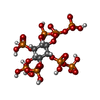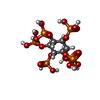+Search query
-Structure paper
| Title | Cryo-EM structures of the human PA200 and PA200-20S complex reveal regulation of proteasome gate opening and two PA200 apertures. |
|---|---|
| Journal, issue, pages | PLoS Biol, Vol. 18, Issue 3, Page e3000654, Year 2020 |
| Publish date | Mar 5, 2020 |
 Authors Authors | Hongxin Guan / Youwang Wang / Ting Yu / Yini Huang / Mianhuan Li / Abdullah F U H Saeed / Vanja Perčulija / Daliang Li / Jia Xiao / Dongmei Wang / Ping Zhu / Songying Ouyang /  |
| PubMed Abstract | Proteasomes are highly abundant and conserved protease complexes that eliminate unwanted proteins in the cells. As a single-chain ATP-independent nuclear proteasome activator, proteasome activator ...Proteasomes are highly abundant and conserved protease complexes that eliminate unwanted proteins in the cells. As a single-chain ATP-independent nuclear proteasome activator, proteasome activator 200 (PA200) associates with 20S core particle to form proteasome complex that catalyzes polyubiquitin-independent degradation of acetylated histones, thus playing a pivotal role in DNA repair and spermatogenesis. Here, we present cryo-electron microscopy (cryo-EM) structures of the human PA200-20S complex and PA200 at 2.72 Å and 3.75 Å, respectively. PA200 exhibits a dome-like architecture that caps 20S and uses its C-terminal YYA (Tyr-Tyr-Ala) to induce the α-ring rearrangements and partial opening of the 20S gate. Our structural data also indicate that PA200 has two openings formed by numerous positively charged residues that respectively bind (5,6)-bisdiphosphoinositol tetrakisphosphate (5,6[PP]2-InsP4) and inositol hexakisphosphate (InsP6) and are likely to be the gates that lead unfolded proteins through PA200 and into the 20S. Besides, our structural analysis of PA200 found that the bromodomain (BRD)-like (BRDL) domain of PA200 shows considerable sequence variation in comparison to other human BRDs, as it contains only 82 residues because of a short ZA loop, and cannot be classified into any of the eight typical human BRD families. Taken together, the results obtained from this study provide important insights into human PA200-induced 20S gate opening for substrate degradation and the opportunities to explore the mechanism for its recognition of H4 histone in acetylation-mediated proteasomal degradation. |
 External links External links |  PLoS Biol / PLoS Biol /  PubMed:32134919 / PubMed:32134919 /  PubMed Central PubMed Central |
| Methods | EM (single particle) |
| Resolution | 2.72 - 3.75 Å |
| Structure data | |
| Chemicals |  ChemComp-K0W:  ChemComp-IHP: |
| Source |
|
 Keywords Keywords |  HYDROLASE / Proteasome activator HYDROLASE / Proteasome activator |
 Movie
Movie Controller
Controller Structure viewers
Structure viewers About Yorodumi Papers
About Yorodumi Papers








